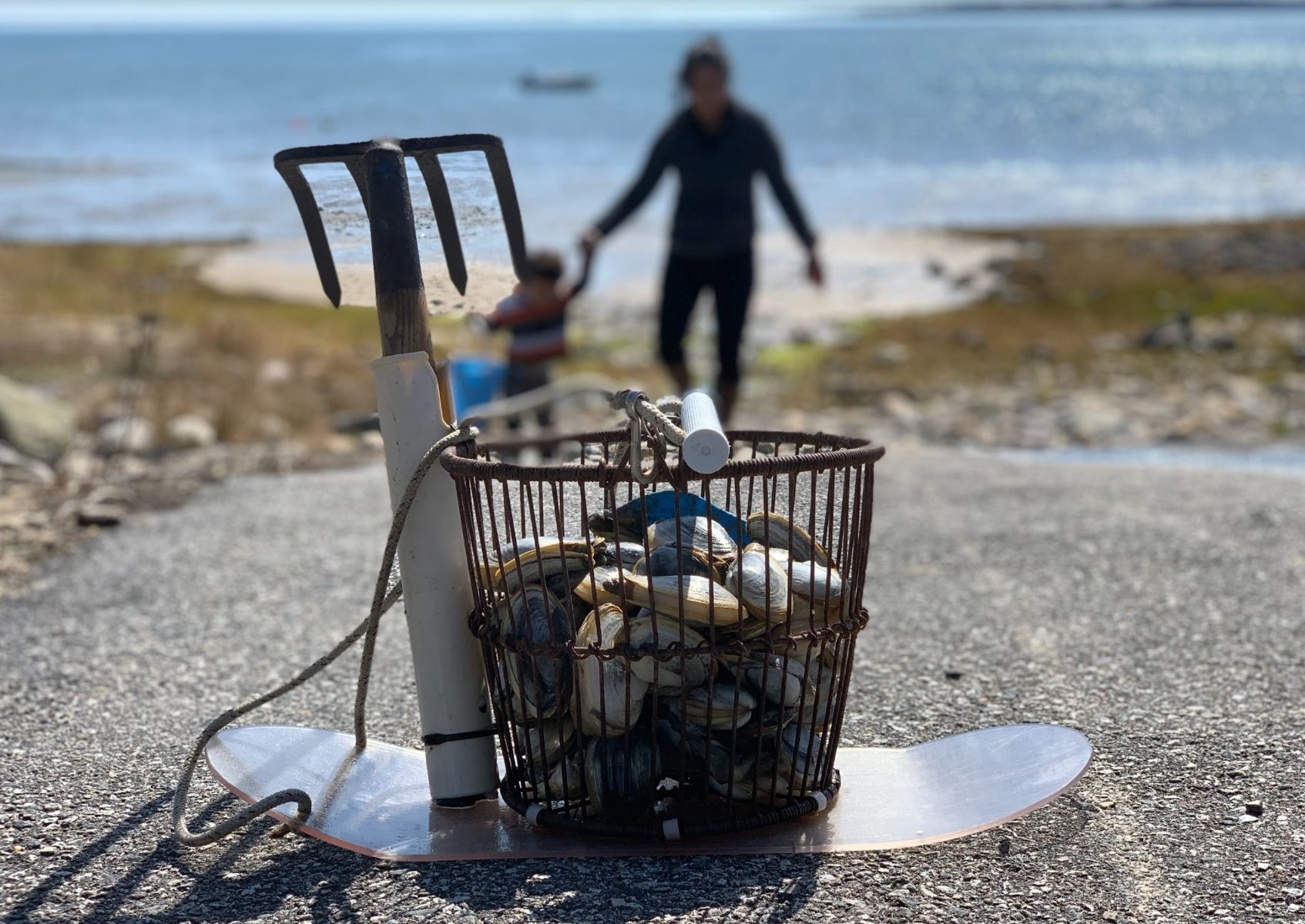He grew up on the South Shore of Massachusetts, clamming on mud flats with his family. Some of his earliest memories are of walking on mud and sand, listening to gulls, tasting salt air while digging up clams. The heavy clamming bucket he dragged got heavier with each new find, the wire digging into his blistering hand.
There had to be a better way…
So, Steve Harhen invented the ‘QuahogSki’, a toboggan-like contraption that glides across the mudflats carrying the bucket as he hunts for clams. He was 10. It took a couple hours to make — a simple solution to a real-world problem. To this day, Steve uses the QuahogSki when he goes clamming, now sharing the adventure of the hunt with his small son.
Solving problems by building things is in Steve’s DNA. His father is a mechanical and electrical engineer and an entrepreneur in the medical device field. Twenty years after creating the QuahogSki, Steve is still solving problems through innovation and design, simply, as Chief Engineer at Rx Bandz.
Allergy Force recently caught up with Steve to take a peek inside his ‘lab’ at what it takes to innovate a new and different auto-injector platform for delivering emergency medications.
What is Rx Bandz? Rx Bandz is a bold start-up on a mission to make life easier for people who need to keep emergency medication at their fingertips — think allergic reactions or opioid overdoses or low blood sugar situations. Rx Bandz is innovating a highly durable, extremely portable, miniaturized auto-injector. They are currently working with the Department of Defense (DoD) and the FDA for military and civilian use. Steve is the engineering and design brains behind the miniaturized auto-injector.
“Creativity is intelligence having fun.”
—Albert Einstein
What propels Steve? Where does his passion for building devices that pair mechanical delivery systems with pharma benefits come from?
Steve first worked in medical devices for Johnson & Johnson, after earning degrees in biomedical engineering and biomaterials from Rutgers and the New Jersey Institute of Technology. He worked on J & J’s Evarrest Fibrin Sealant Patch — essentially an absorbable fabric pad with biologics that helps surgeons stop problematic bleeding during surgery.
Steve left J & J to pursue a PhD at Villanova, working on tissue engineering. A PhD program prepares you over years to become an expert in a narrow area of specialization. After seven years, however, the glacial pace of earning a PhD left Steve wanting more. When he learned that Rx Bandz wanted to improve its auto-injector design, he jumped to submit a proposal. He hoped for a chance to apply his entire range of know-how and creativity in a faster paced and broader environment.
“If it needs to be built, I can probably build it or know how to get it built.”
After reviewing detailed replies to the RFP — from Steve and other innovative engineers — Rx Bandz CEO and Founder, Jessica Walsh chose Steve’s concept.
Whether mechanical, electrical or software development, Steve can tap into his diverse background for problem solving inspiration and skills. Creating Rx Bandz’ miniaturized auto-injector requires deep mechanical engineering expertise. His experience in rapid prototyping, from 3D printing to laser cutting to CNC (computer numerical control) milling, is tailor-made for the effort.
“The most important step a man can take. It’s not the first one is it? It’s the next one. Always the next step.”
—Brandon Sanderson Oathbringer
The medical device field isn’t an easy field where success is guaranteed the first time a design’s created, or a device goes to market. One trait successful entrepreneurs have in common is their doggedness to persevere. Innovating a platform to deliver an emergency medication takes tremendous amounts of iteration, practical optimism and integrity to succeed, whether it’s reworking grants for the most compelling submission, deciphering and meeting multi-phased FDA and DoD vetting processes, or reconfiguring products to meet various customer needs.
Steve explains, “When you build new things, they may not work out right out of the gate, but you keep trying. Again, and again.”
The Rx Bandz team went through numerous design iterations to get to where they are today. They tested all kinds of prototypes with people familiar with their use, as well as with people who were totally unfamiliar. The team saw that when people try to use an auto-injector and they’re not trained on it, they definitely need extra time to figure it out. Customer preferences varied greatly.
They didn’t get it right the first time. Or the next time. Or the time after that. Thomas Edison had a saying—I have not failed. I’ve just found 10,000 ways that won’t work. Steve laughs, “That pretty much sums up innovation and entrepreneurship!”
“There’s a reason you don’t stand in a lightning storm.”
Through their research, the team learned that the auto-injector device couldn’t be too small. It couldn’t be too big. Nor could it be too obvious when carried. They learned that the problems with current auto-injector designs are not just limited to people who suffer from anaphylaxis, but also impact first responders and military personnel. They heard frustrations regarding short shelf lives. They learned how critical durability is in different environments. They realized that the currently available devices could be better for everyone.
Steve reflects, “The more you learn about customer needs, the better device you can make. Our customer discovery work confirmed that people often choose not to carry their auto-injectors because they’re too big, they’re a hassle to carry, and importantly, the perceived risk of a reaction is low.”
It is hard for people with active lifestyles to keep a cumbersome auto-injector at hand while out and about living their best life.
- Steve saw this as a lifeguard on the beach — beach goers seem to pack up the entire house for a day at the beach, but don’t pack their auto-injectors.
- He saw this when he hiked through extremely remote pine forests with a buddy who was allergic to pine nuts — who wants to climb a mountain with an extra {likely unnecessary} item in the backpack?
- He’s lived this with his cousins who require multiple auto-injectors to manage their food and venom allergies.
“Dying from anaphylaxis may be an unlikely event,” Steve explains, “but there’s a reason you don’t stand in a lightning storm.”
“If people can do something wrong with an auto-injector, they will try to do it.”
“When designing,” Steve explains, “You have to analyze how people will hold a device, remove the cap, fire it. You also have to factor in people’s state of mind, in a chaotic, life-threatening situation. We’ve seen people in a panic try to open an auto-injector with keys.”
Steve believes that, “All the work we did to design the device to be what customers want was time well spent.” According to Steve, when you design an everyday-carry auto-injector, three things are paramount:
It has to be intuitive. How a person uses a device is going to determine if they can get the therapy or not. Can the person use the device or not? If patients can’t figure out how to use it, they won’t get their medicine when they need it. Over 18 months, Rx Bandz worked through at least 30 major design changes and many, many more adjustments to make their auto-injector intuitive.
It has to be non-intrusive. If a device is bulky and hard to carry — if it disrupts the flow of a person’s lifestyle — people won’t carry it with them everywhere (or anywhere). All. The. Time. If patients don’t have their medication with them, they won’t get their medicine when they need it. Rx Bandz has perfected the auto-injector’s miniaturization, developing an auto-injector that’s small enough to carry unobtrusively on a key ring or belt loop, for example.
It has to work 100% of the time. You have to be able to manufacture the highest quality device that works 100% of the time. You can’t afford tradeoffs. Assuming patients carry their auto-injectors with them everywhere, it has to work 100% of the time on demand. To ensure the quality of their auto-injector, Rx Bandz and Weiss-Aug Co. launched a strategic partnership in 2019 to manufacture and supply commercial quantities of the Rx Bandz auto-injector, for FDA testing and then for the commercial market, as soon as it’s approved by the FDA.
“Medical care is always going to advance. There’s a real human drive to help make things better…to improve quality of life.”
All new entrants to the medical device field have significant hurdles to clear to gain FDA approval for their products. Companies have to gather vast amounts of data to prove that their devices are safe and effective. While a good thing for U.S. consumers, the FDA’s stringent requirements for approving new medical devices significantly stretch go-to-market timelines. It’s hard for innovative start-ups to survive because not only is significant technical depth required, but significant and sustained financial investment over years is also necessary.
Despite the regulatory challenges, innovation is rampant in the food allergy and epinephrine delivery space. Different modes for epinephrine delivery are bubbling up, like dosing via nasal spray or via needleless injectors. But, as one would expect, there are tradeoffs in efficacy and risks with these new and different delivery modes. There remains a great need in the market for a reliable, intuitive, needle-based epinephrine auto-injector.
We’re watching Rx Bandz’ progress with interest because we believe their miniaturized auto-injector will simplify life for the millions worldwide who manage food allergies and other chronic conditions that require emergency medication.
Thank you, Steve, for this peek inside your ‘lab’! Your work gives us great hope that life with food allergies will get easier and more convenient until cures are found.

The Allergy Force app…empowering people to live their best lives with food allergies |
|
| The Allergy Force Changemaker Series shines a light on movers and shakers in the food allergy community who drive change and bring positivity to the space for the benefit of the entire community. | |
Image Credits: Thank you to Steve, Rx Bandz and Johanna Buguet on Unsplash for use of the images


